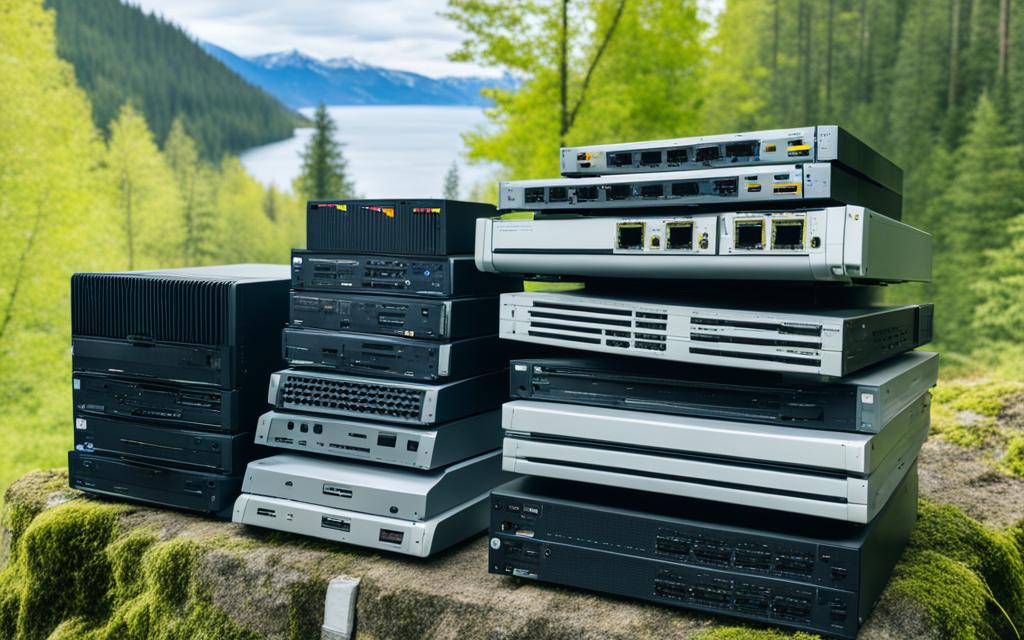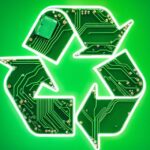Sustainable IT Equipment Disposal Techniques
When it comes to disposing of outdated IT equipment, it is crucial to prioritize sustainability, eco-friendly practices, responsible recycling, and data security. Old IT equipment contains harmful heavy metals that can contaminate the environment if not disposed of properly.
Recycling old computers and other electronic devices is a comprehensive process that not only removes toxic elements but also reduces pollution. However, it can be challenging to recycle old computer technology due to its complex nature.
That’s where specialized services for IT asset disposal come in. These services ensure safe and secure recycling methods that not only protect the environment but also safeguard sensitive data. By adopting these eco-friendly practices, businesses can enjoy the benefits of sustainability while effortlessly disposing of their IT assets.
Upgrading IT systems may be necessary due to external changes, such as advancements in technology or compliance requirements. However, it is essential to consider the environmental impact of such upgrades. By incorporating sustainable IT equipment disposal techniques, businesses can minimize their ecological footprint, reduce resource use, and contribute to a more sustainable future.
In the following sections, we will explore the importance of waste reduction strategies for IT equipment, the significance of sustainable and compliant IT asset disposal, as well as tips on how to ensure proper disposal. Join us on this journey towards a greener and more secure IT industry.
Importance of Waste Reduction Strategies for IT Equipment
Improper disposal of IT equipment poses significant risks to the environment. Electronic gadgets contain toxic substances that can contaminate the water, air, and soil, leading to negative ecological impacts. Additionally, the energy and materials consumed during the manufacturing process of IT equipment contribute to carbon emissions and the depletion of natural resources, further exacerbating the ecological footprint.
Implementing effective waste reduction strategies can play a crucial role in minimizing these negative environmental impacts and paving the way for a more sustainable future. Several key strategies can be adopted to achieve this:
- Managing inventory and reusing equipment: By carefully managing IT equipment inventory, organizations can reduce unnecessary purchases and extend the lifecycles of existing devices. This reduces the consumption of resources and energy required for manufacturing new equipment, ultimately minimizing waste.
- Proper disposal and recycling of e-waste: Ensuring the responsible disposal and recycling of electronic waste is essential to prevent its harmful effects on the environment. Recycling not only reduces the volume of waste sent to landfills but also allows for the recovery of valuable resources through the extraction of metals and other components.
- Cutting down on packaging waste: Many IT equipment manufacturers have begun adopting more sustainable packaging practices, such as using recyclable materials or reducing the amount of packaging used. By supporting these environmentally friendly measures and opting for minimal packaging when purchasing IT equipment, businesses can contribute to waste reduction efforts.
- Ensuring data security: When disposing of IT equipment, data security is a significant concern. Securely erasing or destroying data ensures the safeguarding of sensitive information and protects against data breaches. Partnering with reputable IT asset disposal companies can provide the expertise needed to maintain data integrity throughout the disposal process.
- Measures for energy efficiency and e-waste collection programs: Implementing energy-efficient practices and technologies can significantly reduce the operational impact of IT equipment on the environment. Furthermore, participating in e-waste collection programs, whether organized by manufacturers, recycling facilities, or government initiatives, helps ensure that end-of-life devices are properly recycled rather than being discarded improperly.
By embracing waste reduction strategies for IT equipment, businesses can contribute to building a more sustainable future. These strategies not only minimize negative environmental impacts but also present opportunities for cost savings and improved corporate social responsibility.
| Benefits of Waste Reduction Strategies for IT Equipment | Examples |
|---|---|
| Environmental sustainability | Reduced carbon emissions, minimized resource depletion, and protection of ecosystems |
| Cost savings | Lower procurement costs through reduced equipment purchases, and potential revenue from recycling valuable components |
| Data security | Prevention of data breaches and protection of sensitive information |
| Corporate social responsibility | Demonstration of commitment to sustainability and responsible business practices |
Why Sustainable and Compliant IT Asset Disposal Matters
When it comes to disposing of old IT assets, it is crucial to consider sustainability and compliance. Improper disposal methods can have a significant environmental impact and pose security risks. Let’s explore why sustainable and compliant IT asset disposal is essential for a more sustainable future.
The Environmental Impact of Improper Disposal
Improper disposal of IT assets, such as computers and electronic devices, can lead to harmful environmental consequences. These devices often contain hazardous materials, including heavy metals and toxic substances, which can contaminate the air, water, and soil. When these materials end up in landfills or are incinerated, they release pollutants that can damage ecosystems and pose health risks to both humans and wildlife.
The Importance of Data Security
Data security is another significant concern when disposing of IT assets. Whether it’s old computers or storage devices, they often store sensitive information that must be protected. Failing to securely destroy or erase this data before disposal can lead to data breaches and compromise the privacy of individuals and businesses. Therefore, ensuring data security throughout the disposal process is crucial to mitigating these risks.
Sustainable and Compliant Disposal for a Better Future
Sustainable and compliant IT asset disposal is essential for creating a more sustainable future. By responsibly recycling old IT equipment, we can reduce pollution, conserve resources, and minimize our ecological footprint. It allows us to recover valuable materials from these devices and reintroduce them into the manufacturing process, reducing the need for new raw materials.
Complying with regulations regarding IT asset disposal is equally important. Many countries have implemented laws and regulations to ensure proper disposal practices and prevent environmental harm. By adhering to these regulations, we can mitigate the negative environmental impact of IT asset disposal and contribute to a safer and cleaner planet.
Overall, sustainable and compliant IT asset disposal is not just an environmental responsibility; it is also crucial for data security. By prioritizing sustainability and compliance in the disposal process, we can protect both the environment and sensitive information, working towards a better and more sustainable future.
How to Ensure Sustainable and Compliant IT Asset Disposal
Properly managing the disposal of IT assets is crucial for mitigating environmental impact and ensuring data security. To ensure a sustainable and compliant IT asset disposal process, follow these steps:
- Develop an IT Asset Management Policy: Establish a comprehensive policy that outlines the procedures and guidelines for disposing of IT assets in an environmentally friendly and compliant manner. This policy should emphasize the importance of waste reduction, data security, and working with reputable disposal companies.
- Work with a Reputable Disposal Company: Partner with a reputable and certified disposal company that specializes in IT asset recycling and disposal. Look for certifications such as ISO 14001 for environmental management and ISO 27001 for information security to ensure that the company adheres to strict standards.
- Prioritize Data Security: Before disposing of any IT asset, ensure that all data is securely erased or destroyed to prevent any potential data breaches. This can be done through data erasure software or physically destroying the storage media.
- Follow Proper Disposal Procedures: Adhere to proper disposal procedures recommended by the disposal company. This may include dismantling equipment to separate recyclable components, disposing of hazardous materials safely, and recycling non-reusable materials.
- Monitor and Evaluate Waste Reduction Efforts: Continuously monitor and evaluate your waste reduction efforts to identify areas for improvement. Keep track of the quantity of IT assets being disposed of and the percentage being recycled or reused.
By implementing these steps, you can ensure that your IT asset disposal process is sustainable, compliant, and prioritizes data security.
Capturing the Essence of Sustainability and Security
“Effective IT asset disposal combines the principles of environmental sustainability and data security. By developing a robust IT asset management policy, partnering with a reputable disposal company, prioritizing data security, and following proper disposal procedures, organizations can contribute to a sustainable future and protect sensitive information from falling into the wrong hands.”
| Benefits of Ensuring Sustainable and Compliant IT Asset Disposal | |
|---|---|
| Environmental Impact Reduction | Minimizes pollution and waste generation, conserves valuable resources, and reduces the ecological footprint. |
| Data Security Assurance | Prevents data breaches and protects confidential information, safeguarding the organization’s reputation. |
| Compliance with Regulations | Ensures adherence to local, national, and international regulations governing IT asset disposal, avoiding legal penalties. |
| Cost Savings | Recycling and reusing IT assets can result in cost savings compared to purchasing new equipment. |
| Corporate Social Responsibility | Enhances the organization’s reputation by demonstrating a commitment to sustainability and responsible business practices. |
Implementing sustainable and compliant IT asset disposal practices not only benefits the environment but also safeguards sensitive data and ensures legal compliance. By prioritizing data security, recycling and reusing IT assets, and working with reputable disposal companies, organizations can contribute to a more sustainable future while maintaining the highest security standards.
Conclusion
In conclusion, sustainable and responsible IT equipment disposal is crucial for minimizing negative environmental impacts and ensuring data security. Recycling old computers and gadgets through specialized services allows for the removal of harmful heavy metals and reduces pollution. Proper waste reduction strategies, such as managing inventory, reusing equipment, and minimizing packaging waste, can contribute to a more sustainable future.
Furthermore, the secure destruction or erasing of data is essential to prevent data breaches and protect sensitive information during the disposal process. By complying with regulations and working with reputable IT asset disposal companies, organizations can ensure sustainable and compliant practices.
In summary, adopting comprehensive IT asset management policies, prioritizing data security, and monitoring waste reduction efforts are key steps to ensure responsible IT equipment disposal. By doing so, businesses not only contribute to a greener environment but also safeguard their data and reputation. Embracing eco-friendly practices in IT asset disposal will pave the way for a more sustainable future.
FAQ
What are some eco-friendly practices for IT equipment disposal?
Recycling old computers and electronic gadgets is a comprehensive process that removes harmful heavy metals and reduces pollution in the environment.
Why is it difficult to recycle old computer technology?
Recycling old computer technology can be challenging due to the presence of toxic substances that need to be properly disposed of and the need for secure data erasure.
What are the benefits of recycling IT equipment?
Recycling IT equipment not only prevents harmful substances from polluting the environment but also conserves resources and reduces carbon emissions from the manufacturing process.
Why is secure data disposal important when disposing of IT assets?
Securely erasing or destroying data is crucial to prevent data breaches and protect sensitive information from falling into the wrong hands.
How can I ensure sustainable and compliant IT asset disposal?
Developing a comprehensive IT asset management policy, working with a reputable disposal company, and prioritizing data security are essential steps to achieve sustainable and compliant IT asset disposal.
What are some waste reduction strategies for IT equipment?
Managing inventory and reusing equipment are effective strategies to reduce waste and minimize negative environmental impacts.
Why does sustainable and compliant IT asset disposal matter?
Sustainable and compliant IT asset disposal is crucial to mitigate negative environmental impacts, protect data security, and contribute to a more sustainable future.
How do improper IT asset disposal practices affect the environment?
Improper disposal of IT assets can lead to environmental pollution, damage ecosystems, and pose risks to human health due to the presence of hazardous materials in electronic waste.
What is the role of a reputable IT asset disposal company in sustainable disposal?
Working with a reputable IT asset disposal company ensures that IT equipment is disposed of responsibly, with proper data security measures and compliance with environmental regulations.













